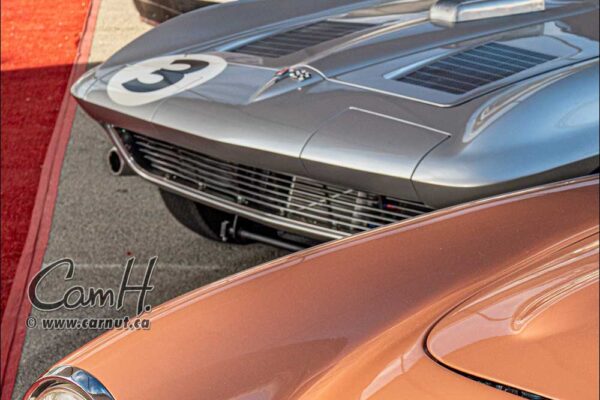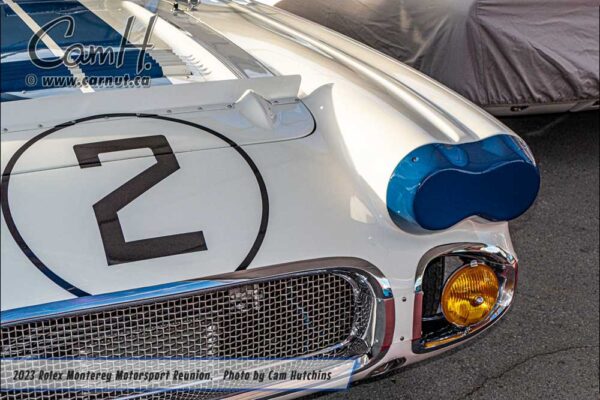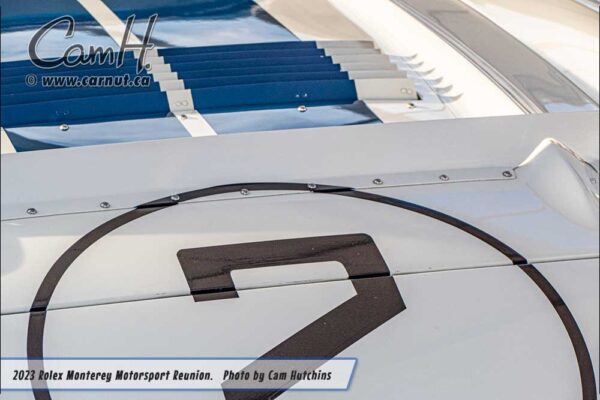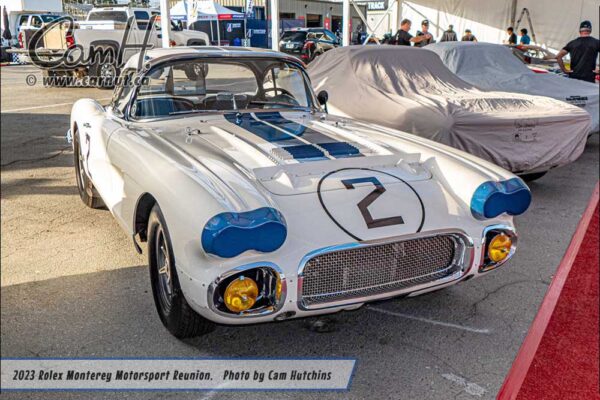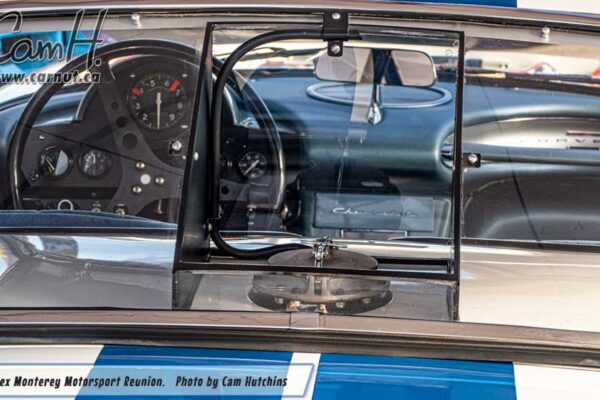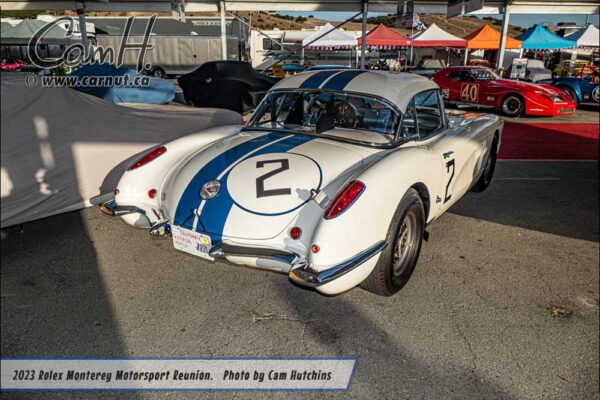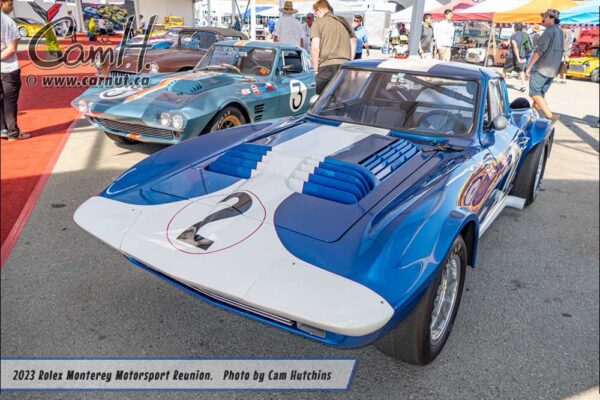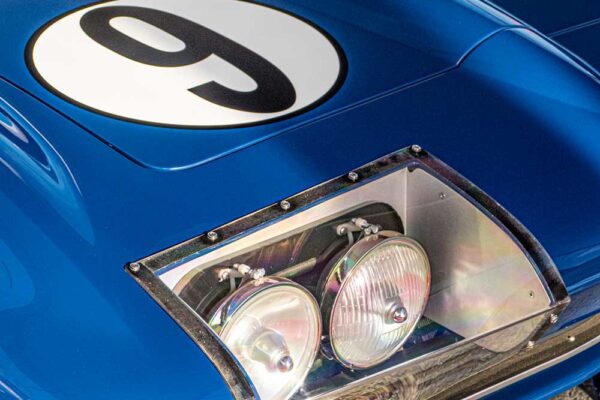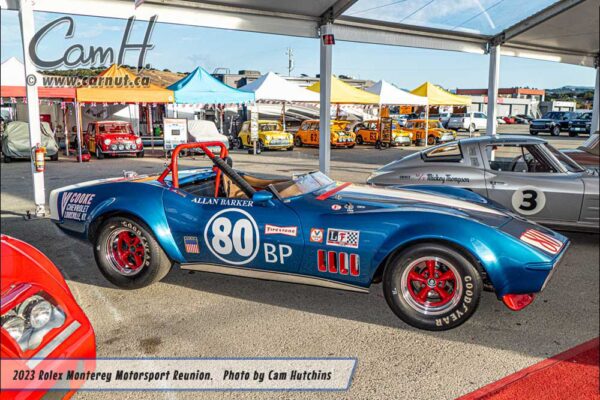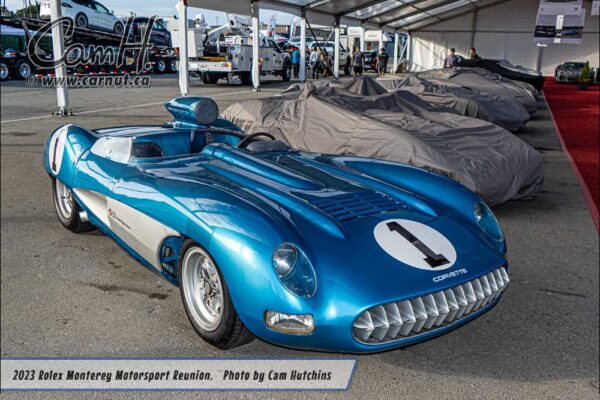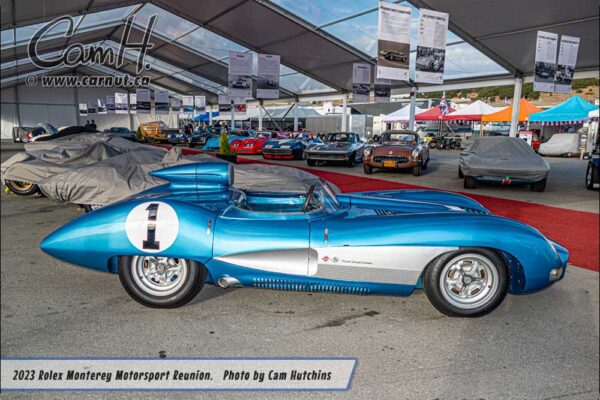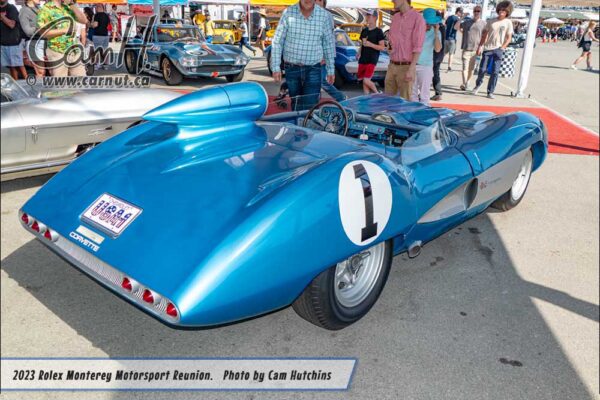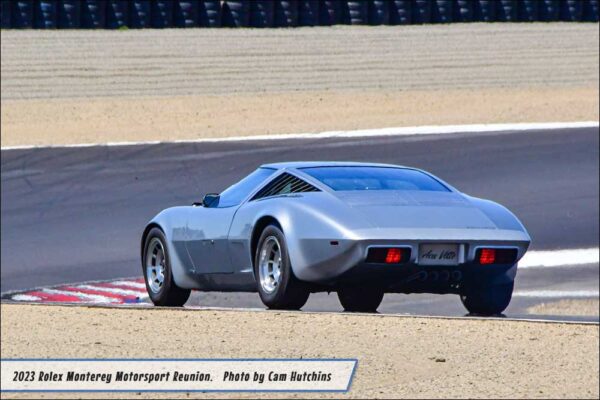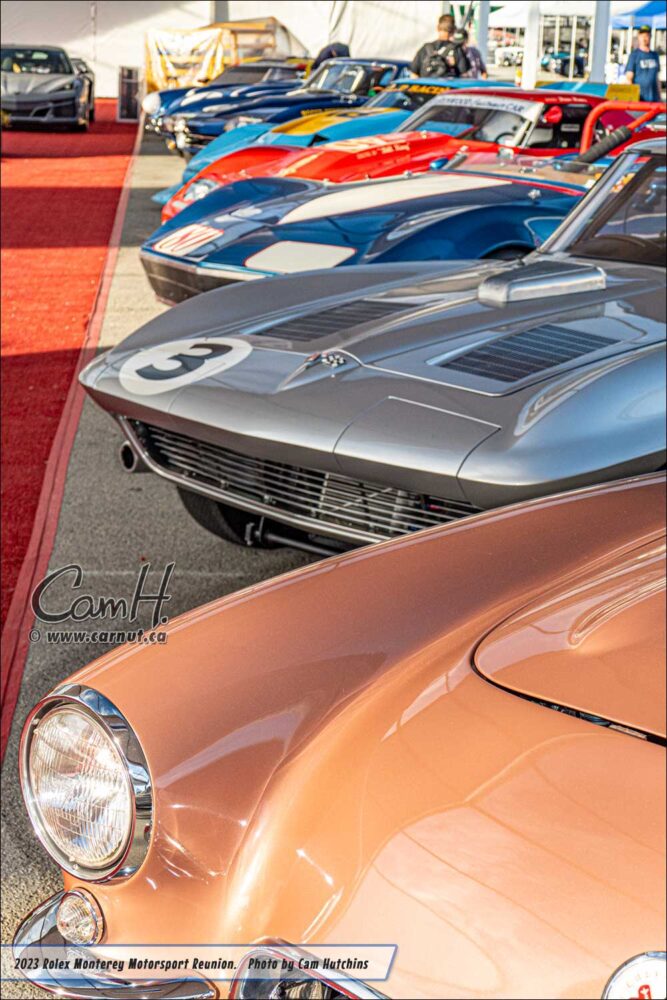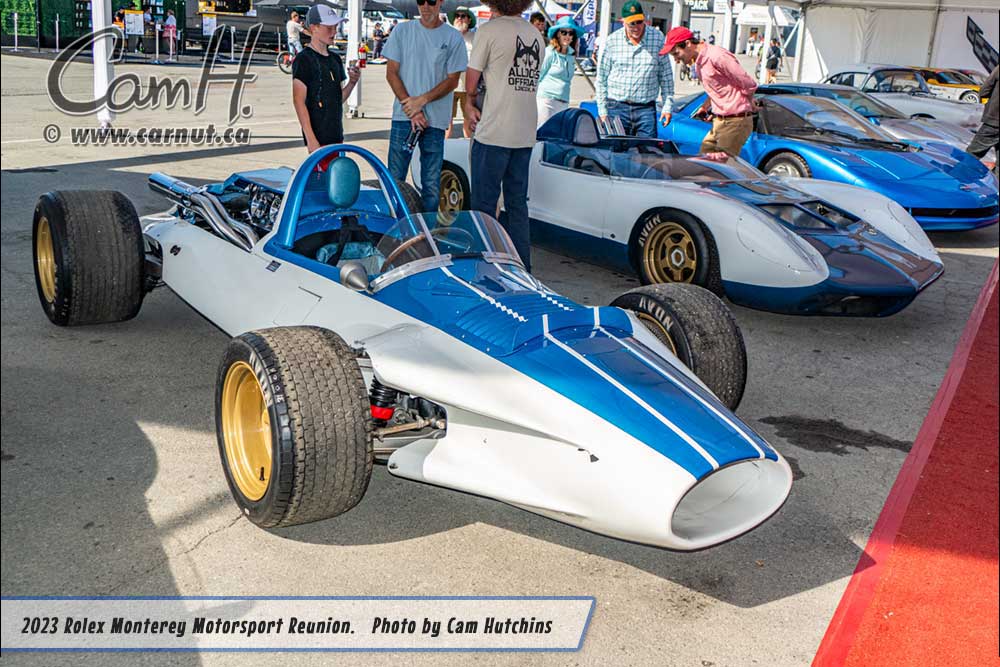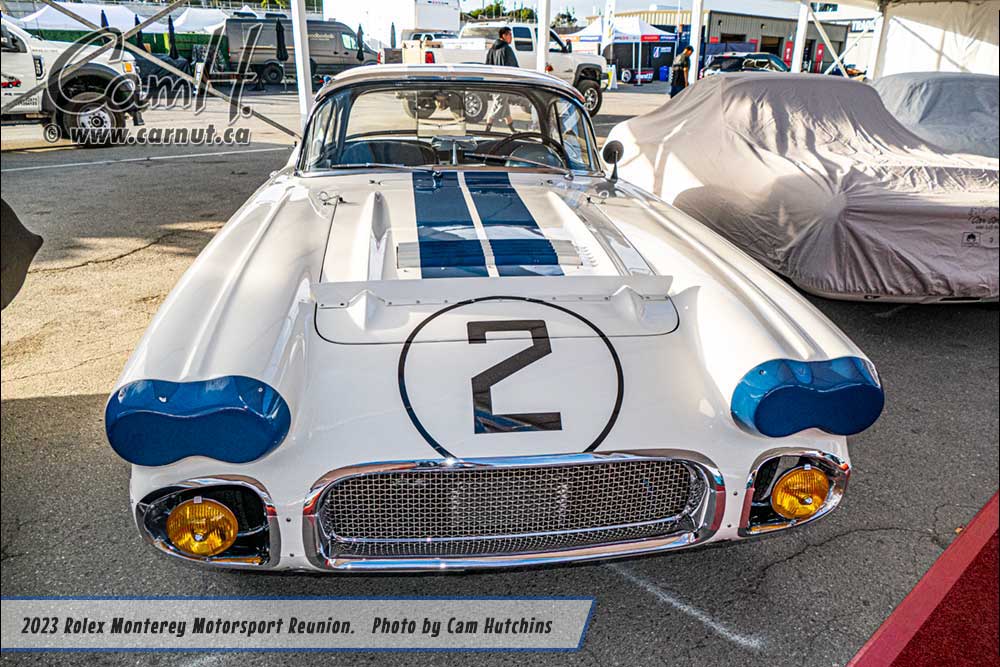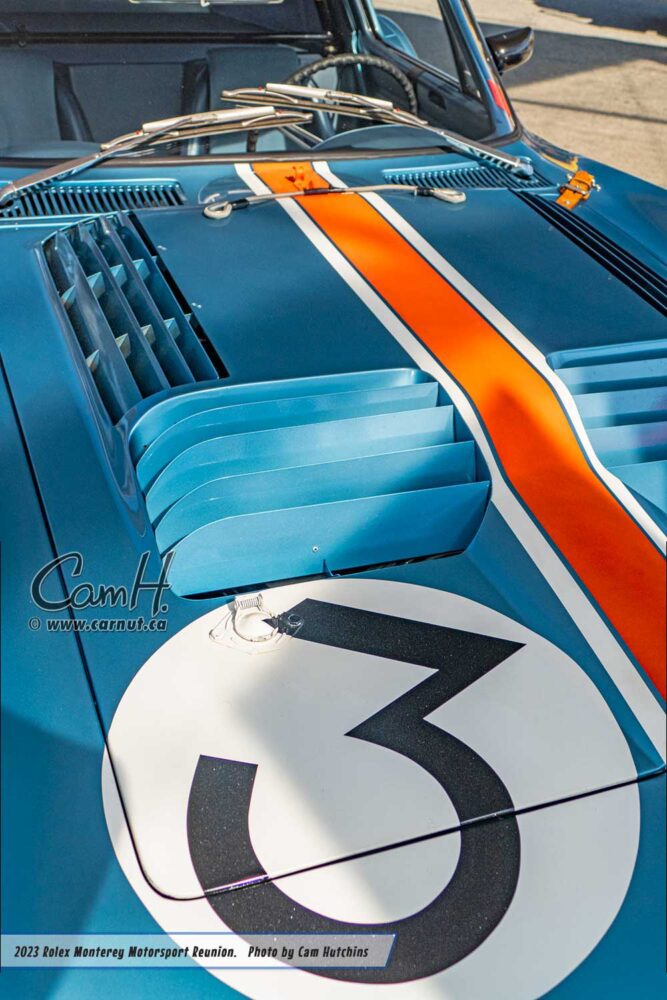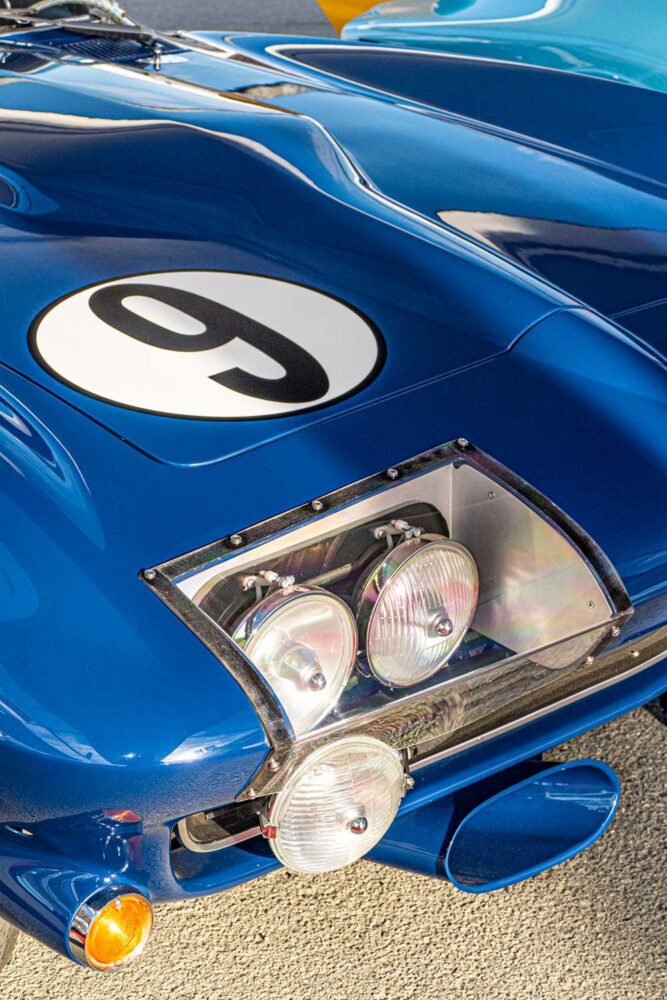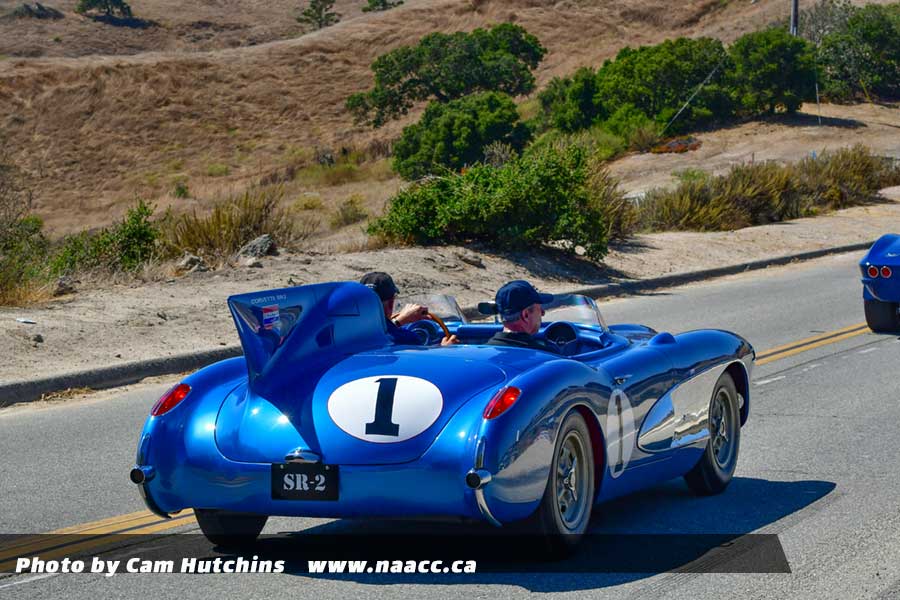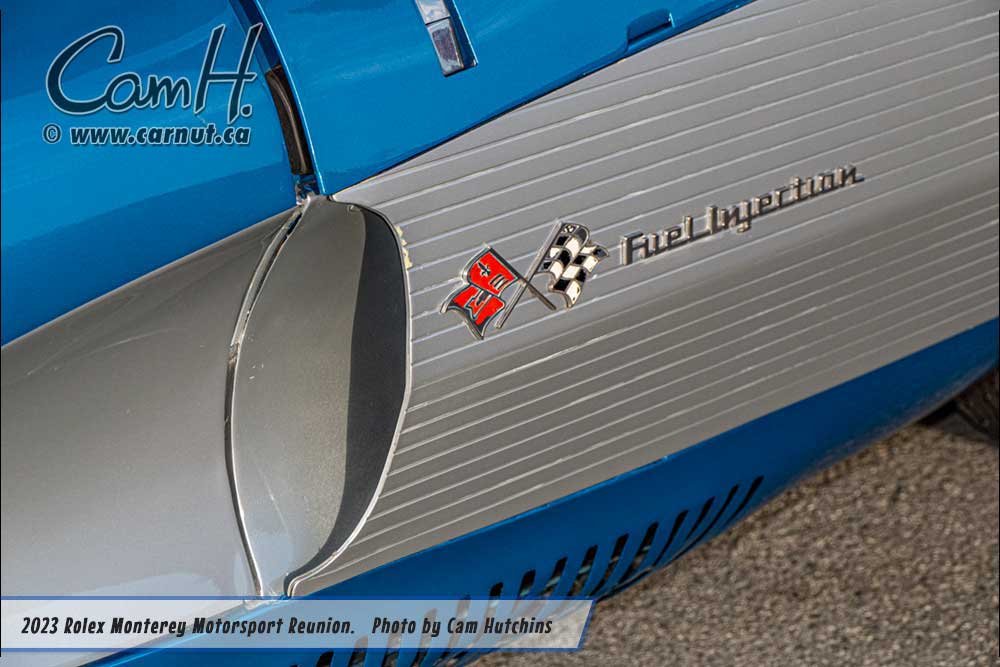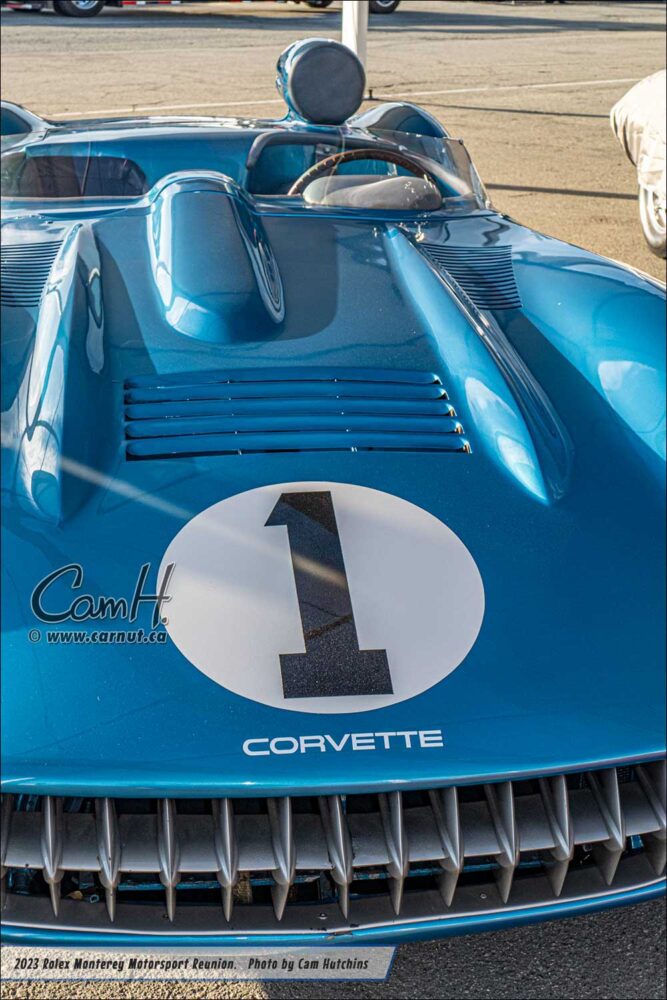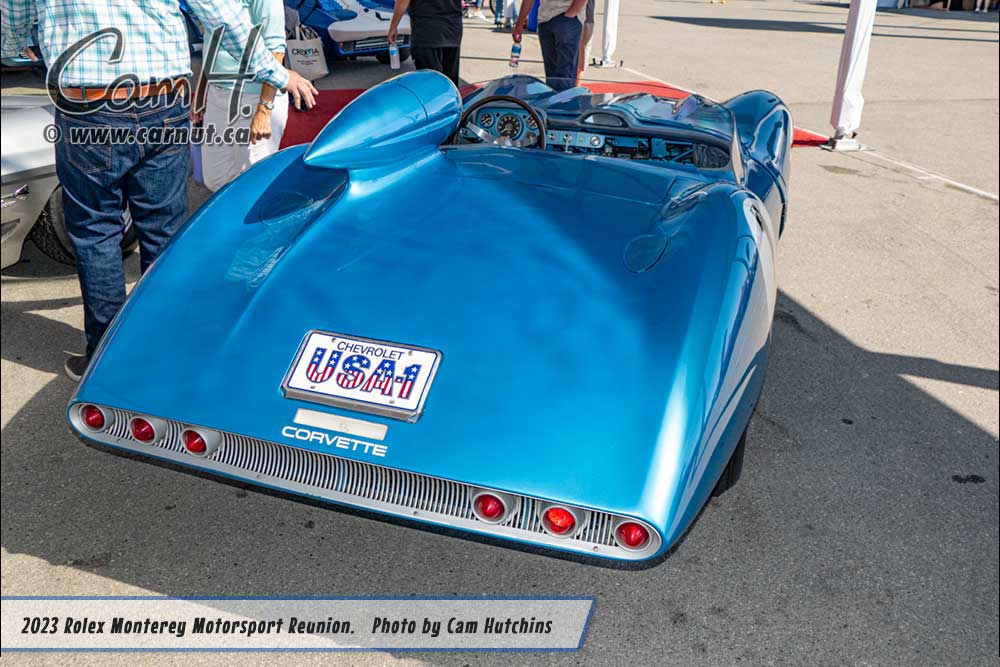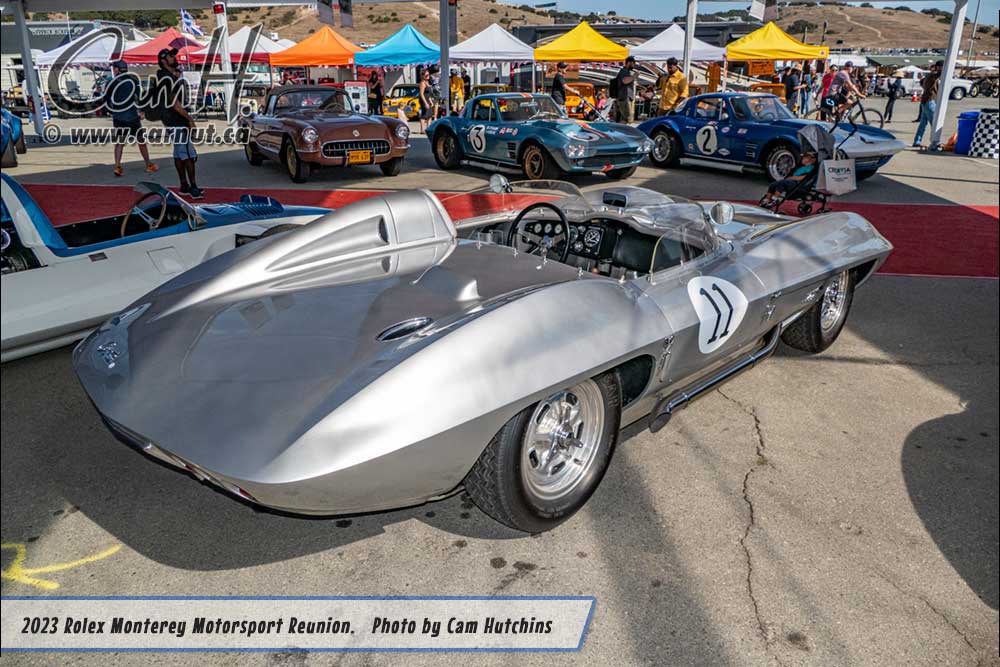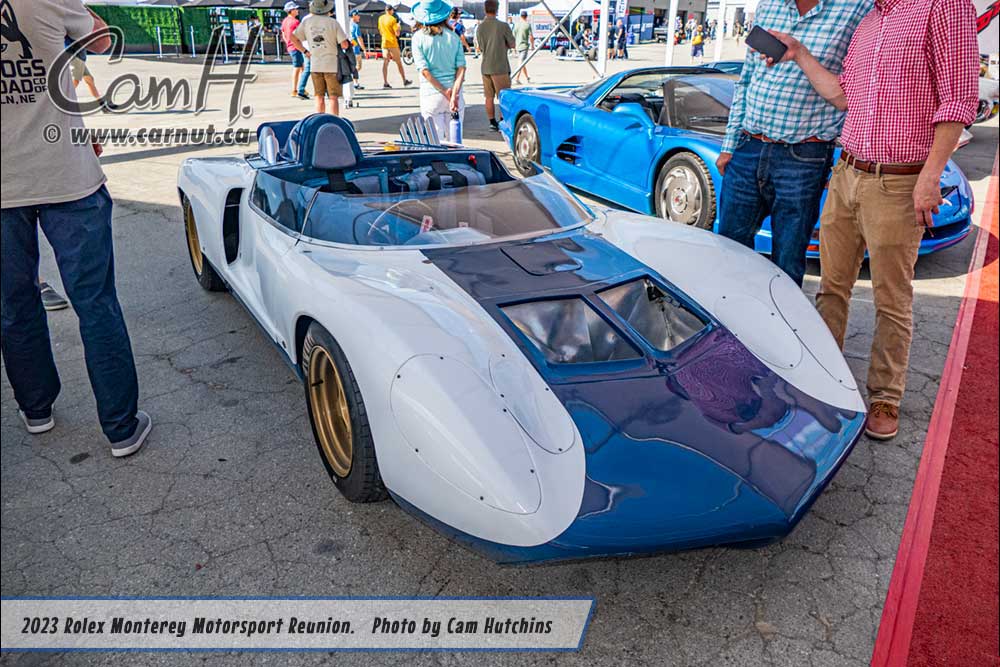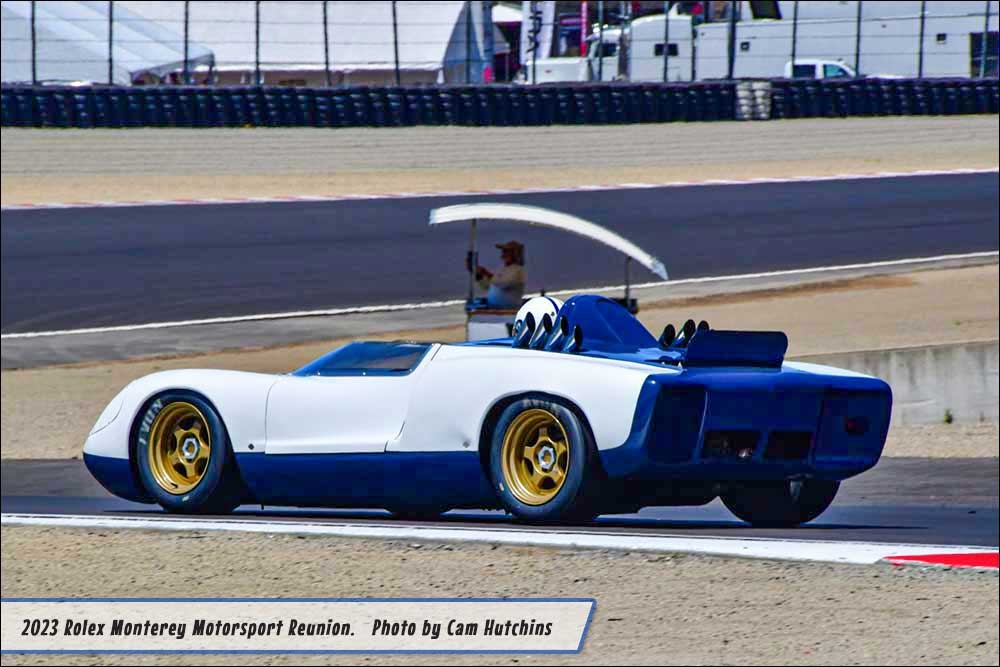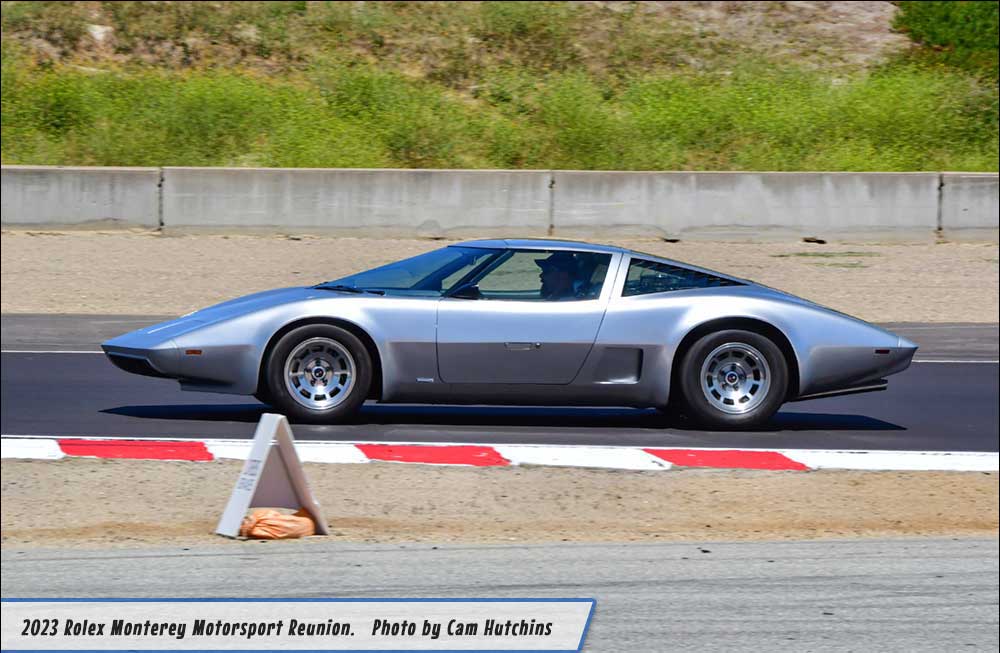By JJ Carlson and Cam Hutchins
This spectacular weekend racing event hosted over 400 historically significant race cars. The race vehicles were chosen on the basis of the car’s racing history, prominence, and authenticity. There were countless historic cars that legends are made from. Some of the Marques included Allard, MG, Jaguar, Ferrari and Lotus, just to mention a few. There was also a variety of pre 1915 racers as well. These vehicles drove exhibition laps at speed.
The races were held at the Weather Tech Raceway Laguna Seca from August 16th through August 19th in front of thousands of spectators. Many spectators took advantage of the local camping facilities located on site. If camping, my advice is to book reservations ten months in advance.
This event is family-friendly and offers a host of amenities such as a sit-down out door food services, a gift shop, driver interaction and shuttles. The entrance to see the cars in the paddocks is included with admission to the races, interact with crew and drivers, look at the iconic racecars up close and see the cars you read about in magazines decades ago. Corvette is celebrating it’s 70th anniversary and there is an incredible display of iconic Corvettes from the past and CERV I, II and III!. I highly recommend taking in the fabulous event in 2024.
See pictures provided by NAACC webmaster and photo journalist Cam Hutchins.
The 2023 Rolex Monterey Motorsport Reunion
Report by Cam Hutchins
This year marks the 40th anniversary of my parents taking us to the Historic races at what was then known as, Laguna Seca. My brother and I carried on the tradition for the next 4 years and then I went as often as I could, and this year was my 20th year at the event, now known as the Rolex Monterey Motorsports Reunion at Weather Tech Raceway Laguna Seca.
Another Canadian who has been a few times is Canadian Motorsports Hall of Fame member Ron Fellows.
Not only does 2023 mark Ron Fellows 4th trip to the historic races, this year he is named Grand Marshal for the Rolex Monterey Motorsports Reunion. For 2001 and 2002 Fellows has won the GTS class at the 24 hours of le Mans, and was the overall winner of the Daytona 24 Hours in 2001! It was great to have a fellow Canadian at the event, but with so many events to cover I never actually got to meet him, but I was thrilled to watch him win the Group 4 race for 1981 to 1991 GTO / Trans-Am cars.
The Rolex Monterey Motorsports Reunion now run around 400 significant vintage race cars as well as the “Tall Tires” group that does not race, but due to safety concerns, just puts on a great display on the track. The action on the track is second to non, but the pits come in a very close second. This year was the 70th anniversary of the Chevrolet Corvette, and the Paddocks of Weathertech Raceway Laguna Seca had a serious collection of historic Corvettes on display with GM Heritage running in display laps the CERV I, CERV II, CERV III, and the Aerovette. All three 1960 C-1 Corvettes that Briggs Cunnigham campaigned at Le Mans were there, but because of the sheer quantity of cars in the pits and racing to photograph, I missed one of the cars, as the owner either put the car cover on early and then left early to make it to a show on the other side of America.
I have to admit I have a few favorite groups of cars to watch, some involve cars I may actually be able to afford and some are the greatest sounding cars on the planet, The Trans Am and Can Am cars are amazing to watch and listen to!!!
Group 4 1981-1991 GTO/Trans Am
1 #2 1987 Protofab Corvette Ron Fellows
2 #10A 1986 Dillion Camaro Octavio Rincon
3 #8 1986 Protofab Z/28 Rick Jeffery
4 #28 1987 Chevrolet Camaro Walter Brown
5 #66 1991 Roush Mustang Chris Liebenberg
Of course not driven by a Canadian, the amazing Sadler MK4 was built by a Canadian Bill Sadler, and is as thrilling to watch today as it was over 60 years ago.
Group 12 – 1947-1960 Front Engined Sports Racing and GT
1 #84 1959 Sadler MK4 Greg Meyer
2 #6 1958 Lister Knobbly Al Arciero
3 #42 1956 Lotus Xl Brian MacEachern
4 #19 1958 Devin SS Nicholas Colonna
5 #25C 1953 Tatum GMC Blake Tatum
No Canadians in the top 5 of this race of Can-Am cars, but the series was named for Canada so they are all winners, and all sound amazing with big monster V8 power!
Group 7 – 1966-1974 Can Am/ 1963-1968 USRRC
1 #5 1971 McLaren M8F Alex MacAllister
2 #0 1969 Porsche 917PA Gunnar Jeannette
3 #25 1972 McLaren M8F Chris Springer
4 #48 1970 McLaren M8D Zak Brown Wakefield UK
5 #51 1968 McLaren M6B Niky Griot
Another amazing class to watch is the Trans Am cars from 1966 to 1972. Canadian Peter Klutt from Halton Hills, Ontario did us proud with a third place out of 30 cars in this race.
Group 8 – 1966-1972 Historic Trans Am
1 #64 1969 Chevrolet Camaro Z/28 Chad Raynal
2 #19 1969 Chevrolet Camaro Joshua Feiber
3 #63 1967 Ford Shelby 289 Peter Klutt Halton Hills ON White 10
4 #6A 1971 AMC Javelin Bill Ockerlund
5 #2 1972 AMC Javelin Ken Epsman
Another thrid place finish by a Canadian is the 1965 Shelby Cobra driven by Lorne Leibel of Willowdale ON.
Group 10 – 1955-1967 SCCA Production-Large Displacement
1 #86 1963 AC Shelby Cobra Philip Kadoorie Chessington UK
2 #96 1964 Ford Cobra 289 Jim Farley
3 #96A 1965 Shelby Cobra Lorne Leibel Willowdale ON
4 #14 1966 Bizzarrini 5300GT Strada John Fudge
5 #17 Patrick Byrne 1963 Chevrolet Corvette
The dates for 2024 are:
August 10-11 – Monterey Pre-Reunion & Corkscrew Hillclimb
August 14-17 – Rolex Monterey Motorsports Reunion
Weathertech Raceway Laguna Seca
1021 Monterey Salinas Hwy
Salinas, CA 93908
_______________________________________-
1956 Competition Type Corvette SR Model.
Production VIN 56S002834
Often referred as the SR-1 Corvettes, they were properly called Corvette Model SR for Sports Racer. 6 were built at the Chevrolet St Louis facility. used 11 of the 13 SR available options including a shortened steering column and dual fan belts on the engine, but not the 37 gallon gas tanks. The cars were built in early June and have Halibrand Magnesium knock-offs and small air scoops to aid in cooling the rear brakes. The brakes had metallic linings and were oversized, the exhaust had slightly enlarged pipes and a very short muffler and dumped out the side before the rear tires. This car was painted Aztec copper but the first owner painted it red. The second owner Bruce Geisler, took it to California and won 27 Drag races in a row. The NHRA took it to Hawaii July 1957 and he won his class and eliminator class as well as going in a car show. In October 1957 he set a record at El Mirage.
Owned by John and Sally Neas Tulas Oklahoma.
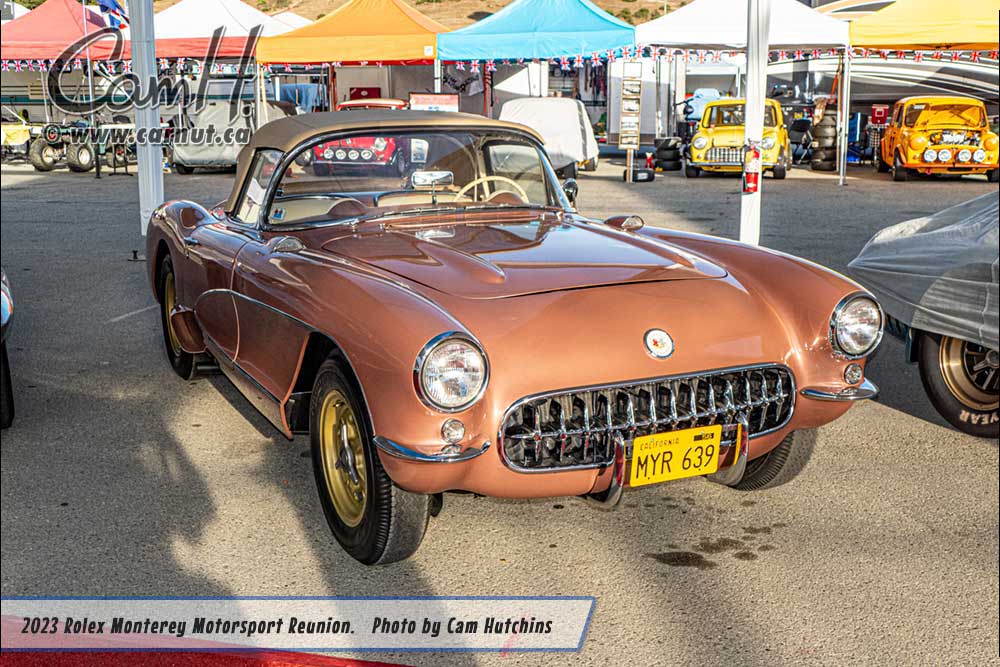
_____________________________

Number 11 1956 CORVETTE SR-2
Chassis number 1 of 2, powered a 331 c.i. V8 produces 240 HP and a 140 mph plus top speed.
Harley Earl was VP of styling for General Motors, and championed Corvette’s creation in 1953. Harley’s son, Jerome, was racing a Ferrari in 1956 and his father was told by the top brass of GM that it didn’t look right that Jerome was racing a Ferrari and that he should be racing a Corvette. Harley told Jerome that he would build him a special Corvette race car. Thus, the first GM purpose-built and sponsored Corvette race car. The SR-2 had a successful racing history and represents the finest combined efforts of Corvette and General Motors in the Golden Era of Racing. Notable drivers included Jerome Earl, Dick Thompson, John Fitch, Bud Gates, Jim Jeffords, and Augie Pabst.
_______________________________________________________________________________________________________________________
1957 CHEVROLET CORVETTE SS
ENGINE 283 Fuel InJected V8 with 310 hp and 150 mph top speed Built in the spring of 1957 to participate in internatronal sports car racing, the Corvette Super Sport project involved many of Chevrolet’s legendary engineering staff including Ed Cole, Harley Earl, Zora Arkus-Duntov, Bill Mitchell, and Harry Barr. Chevrolet entered the SS in the 12 Hours of Sebring with the Argentinran driving Ace Juan Manuel Fangio and Britam’s Stirling Moss selected to drive the SS, but both drivers were released when the SS was not completed on time for testing. The Corvette SS was driven instead by Italian Piero Taruffi and American John Fitch Starting the race with virtually no practice, a variety of handling and braking problems beset Fitch and Taruffi from the outset, and the SS withdrew due to overheating after only 23 laps. The Corvette SS’s only race appearance was at Sebnng due to a decision by executives of the Automobile Manufacturers association (AMA) to prohibit automakers from directly participating in motorsports As a result, enthusiastic plans to compete in the upcoming 24 Hours of Le Mans were ended.

________________________________________________

1959 CHEVROLET CORVETTE STINGRAY RACER
From the GM HERITAGE COLLECTION
The Corvette Stingray Racer began life as a challenge from William L. “Bill” Mitchell who tasked a group of young designers to develop a revolutionary theme for an all-new Corvette. Research B Studio consisted of chief designer Bob Veryzer and his team of Peter Brock, Gene Garfinkle, Chuck Pohlmann, and Norm Neumann. Two full-size models were created: a coupe based on a theme by Brock and a roadster variant done by Pohlmann. Final design for these cars was by a team led by Larry Shinoda and Tony Lapine working in a secret studio.
The Stingray Racer debuted on the racing circuit with a red livery in 1959 but did not wear a Chevrolet or Corvette badge because of GM’s adherence to the AMA ban on factory-supported racing. Powered by a fuel-injected, high-performance version of Chevrolet’s 283 cubic inch Small Block V8 engine, Dr. Dick Thompson drove the car to an SCCA C-Modified class championship in 1960. Spectators who witnessed the Stingray Racer during its two seasons on the track were treated to a preview of key styling elements of the second-generat1on Corvette to come.
1960 CERV I
GM HERITAGE COllECTION
Led by Zora Arkus-Duntov, CERV I was initially pitched as a platform to develop and refine Chevrolet body, chassis and suspension systems. An open-wheeled vehicle with a single seat, the fiberglass body weighed only 80 pounds. As an engineering tool, it served as an essential link between the 1957 Corvette SS, Chevrolet’s last pre-ban factory-built race car, and the new production 1963 Corvette Sting Ray. CERV I proved key to the development and refinement of the latter’s Independent rear suspension. Known as the “R-Car” by Chevrolet Engineering, CERV I was dubbed “The Hillclimber” internally by GM Design as it was intended to scale and attempt a record-setting run at Pikes Peak, ultimately making the run in September of 1960. Design Vice President William “Bill” Mitchell tasked Larry Shinoda with creating the body This work was completed in Mitchell’s clandestine “Studio X” with the help of a technical designer Tony Lapme and studio chief Ed Wayne. CERV I was originally powered by a special lightweight version of Chevrolet’s fuel-injected 283 cubic inch V8 that developed 350 horsepower. It sat amidship and weighed only 350 pounds through the use of aluminum and magnesium components. CERV 1 debuted to much fanfare in November 1960 during the U.S. Grand Prix at Riverside, California. CERV I never officially competed and was relegated to the test track during Its active life. It was powered by no fewer than seven different engines during this time. Its current engine, which it received in 1963, is a 377 cubic inch V8, that produces 500 horsepower and 500 lb-ft of torque. In this configuration, it achieved speeds of over 200 mph on the test track.

______________________________________________

#1 1960 CUNNINGHAM CORVETTE
Original Chassis Engine: 283 c.i. V8 with 290 HP and a top speed over 150 mph
The #1 Cunningham Corvette is a rac1ng endeavor and a milestone of American motorsports history personally driven by Bnggs Cunningham. Developed with the assistance of Zora Arkus-Duntov and h1s team from GM, it is the only Corvette of the trio team that came with aluminum heads. This would be Cunningham’s final all-out effort to win the world’s most challenging race 1n American-built cars with American drivers. It was damaged during the Le Mans race and throughout different ownership saw many body changes., After many years, the car was fittingly returned to the Cunningham family, who then decided to give the project to “Corvette Repair Inc.” to fully restore it to its original 1960 Le Mans livery.
No Info on Number 2
#3 1960 Cunningham Corvette
Powered by a 290 horsepower 283 c.i. V8 and a top speed over 150 mph
This is the very Corvette, #3 that etched Corvette into the history books by capturing 1st in class and 8th overall at the grueling 24 Hours of Le Mans in 1960. Driven by John Fitch and Bob Grossman. they completed 281 laps and 2,340 miles in the the 24 hour period to thake Victory and, thus beginning the legacy of America’s Corvette victories at Le Mans for years to come. The distance would of been greater, if not for the clever icing strategy employed over the last 4 laps of the race to keep the badly overheating engine from failing. It is the only Corvette of the three Cunningham Corvettes to finish the race that year.
_____________________________________________

__________________________
#1 1962 CHEVROLET CORVETTE
CHASSIS 1261 ENGINE: 327 CI V8 WITH 360 hp and a 160+ mph top speed
Delivered in white with red interior, was the only race-prepared Corvette at Le Mans in 1962. The grid size was set by engine size, putting the 5.4 litre Corvette in the number one position The race was in the 13th hour when Jack Turner accidentally lifted the reverse lockout while downshifting at the end of the Mulsanne Straight and selected reverse at speed. Co-driver Tom Settember attempted to continue with only one useable gear in 3rd, but 30 minutes later the fuel-injected drive cable snapped and the race was over, retiring after 150 laps. Following Le Mans, it was shipped back to the U.S. This is the only 1962 Corvette and one of five straight axle Corvettes to compete in the long history of the 24 Hours of Le Mans.
________________________________________
Number 2, 1963 Chevrolet Corvette Grand Sport
Chassis 003 Owned by Larry Bowman
Developed for the FIA series to defeat Shelby’s Cobras, the Grand Sports were fully custom sports prototype racers. With 500 horsepower, and weighing only 2,000 pounds, the Grand Sport used all lightweight parts. 4 wheel disc brakes and fully independent suspensions. They had great success against the Cobras at Road America, Nassau, and Sebring. This car wears its original Livery from the famous 1964 Sebring 12 hour race driven by A.J. Foyt, and has only been owned by 3 owners in the past 50 years.

______________________________________________

Number 3 1963 Chevrolet Corvette Grand Sport Chassis 004
377 cu. in. engine with 485 Horsepower, top Speed 150 mph.
Designed as a Cobra killer, only five Grand Sports were ever bu1lt: GM axed the program. citing its ban on racing. John Mecum, Jr. entered this car under his private team’s flag at Nassau Speed Week in 1963 where, curiously, all the former Grand Sport engineers had arrived for a vacation. Roger Penske drove this car to third place in the Governor’s Cup Race. The livery has been painstakingly restored to reflect its entry in the 12 Hours of Sebring in 1964, with Delmo Johnson and Dave Morgan at the wheel.
_______________________________________

1964 CERV II
GM HERITAGE COLLECTION
The CERV II (Chevrolet Eng1neering Research Vehicle II) was created by Zora Arkus-Duntov to compete in sports car races including Le Mans and Sebring. Capitalizing on lessons learned from CERV I, fabrication began in 1962, but the project was halted when GM canceled all racing projects. The project was resurrected in late 1963 when two parallel and competing mid·engine programs began. Chevrolet R&D began work on the GS·II (Grand Sport 2), while Zora’s team began work on the GS·III (Grand Sport 3, later rechristened CERV II), which was Intended as direct competitor to Ford’s GT 40. CERV 11 was built on a monocoque chassis and featured four-wheel drive and an experimental automatic transmission that drove power to both the front and rear wheels. It was powered by a 5OO horsepower Corvette Grand Sport V8. Displacing 377 cubic inches. this engine ach1eved a top speed of 210 mph and a 0-60 of 2.8 seconds.
GM Design’s Larry Shinoda and Tony Lapine delivered a striking and simple roadster with a low, peaked nose and coved vents along the body side. The rear deck was executed to accommodate twin exhaust stacks. Ultimately, CERV II stalled when GM decided not to compete at the 1964 24 Hours of Le Mans ·t was never shown publicly durmg its active life but was used as a low-profile engineering research tool for many years. In 1969, CERV II was fitted with Chevrolet’s aluminum block 427 cub1c inch V8 engine. This engine, which was available to the public as Regular Production Option (RPO) ZL1, was conservatively advertised as delivering more than 560 horsepower.
_______________________________________________
# 9 1966 CHEVROLET CORVETTE L88
CHASSIS 10566 ENGINE: 427 ci L88 430 HP TOP SPEED 165 mph
There isn’t a more recognizable name in motorsport history than Roger Penske. Penske received a phone call from Zora Arkus-Duntov stating that a racing vers1on of the newly introduced 427 VI Mk IV big block based on the “Mystery Engine” would be available to select racing venues. It was identified as an L88, that had been developed by the Chevrolet Engineering Center. Built with a 427 developmental L88 engine and a competition race package that included J-56 brakes, 36 gallon fuel tank, F-41 suspens1on, prototype 2 73 positraction rear axle and a spec1al prototype cowl induct1on hood, among many other upgrades. It is the only midyear Corvette with back-to-back class wins in the 1966 Daytona 24 Hours and Sebring 12 Hours. Notable drivers included D1ck Guldstrand, George Wintersteen and Ben Moore.

______________________________________________

Number 4 1968 CHEVROLET CORVETTE L88 REBEL
Chassis 009 powered by a 7-litre 427 L88 V8 with 430 HP and a 175+ mph top speed.
This car was built by Toye English’s RED team as the successor to the legendary “Rebel.,. It completed the 1972 24 Hours of Le Mans finished in NART livery as it was part of the famous NART Ferrari Team! This L88 finished 1st in class, and 3rd overall at the 1973 24 Hours of Daytona. The car is equipped with all heavy-duty racing options, the L88 V8, 427 cubic-inch engine with 560 horsepower, 4-speed M22 “rock crusher” and J56 disc brakes with twin-pin calipers. Beautifully and authentically restored by Corvette Repair Inc. and certified by the Sportscar Vintage Racing Association.
_______________________________________
Number 80 1969 CHEVROLET CORVETTE L88 ROADSTER
CHASSIS 194675723028 ENGINE 350 LT1 V8 with 500 HP and 180+ Top Speed.
This is considered to be the winningest Corvette ever, amassing wins at the 1970 FIA Series Daytona and 2nd place at the 12 Hours of Sebring in the GT class. Under the guidance of the Barker brothers, and with sponsorship from V.V. Cooke Chevrolet, the SCCA B Production class was dominated by this race team and car for four years with 26 consecutive race wins and four National Championships from 1969-1972. It was sold in 1972, but the car went on to win two more B-Production titles in 1973 and 1974.

CHASSIS 194675723028 ENGINE 350 LT1 V8 with 500 HP and 180+ Top Speed.
This is considered to be the winningest Corvette ever, amassing wins at the 1970 FIA Series Daytona and 2nd place at the 12 Hours of Sebring in the GT class. Under the guidance of the Barker brothers, and with sponsorship from V.V. Cooke Chevrolet, the SCCA B Production class was dominated by this race team and car for four years with 26 consecutive race wins and four National Championships from 1969-1972. It was sold in 1972, but the car went on to win two more B-Production titles in 1973 and 1974.
____________________________________________

1973 CHEVROLET AEROVETTE
GM HERITAGE COLLECTION
The Aerovette began life as a high performance showcase for the short-lived Rotary combustion engine. Zora set to work modifying his mid-engine prototype to accept this unique powerplant. GM Design Vice President Bill Mitchell instructed Chevrolet chief designer Henry Haga and his assistant Jerry Palmer to design a sports car body with a teardrop shape that recalled the sleek lines and tapered tails of the 1930s Mercedes Benz record-breaking race cars.
The Aerovette debuted at the Paris Automotive Show in October 1973 as the “Corvette 4-Rotor” alongside it’s 2 rotor sibling. An experimental version of GM’s rotary engine that had 4 rotors and developed 350 horsepower provided power for the car. GM designers devoted a great deal of time to realizing a production version of the car and despite the exuberance of the press, a production mid-engined Corvette wouldn’t become reality for another 47 years.
When GM’s rotary engine program was canceled, Bill Mitchell gave the car a new life by replacing it’s engine with a 400 c.i. small block Chevrolet V8. He rechristened this stunning and dramatic design the Aerovette, a name credited to Chuck Jordan.
Zora Arkus-Duntove is on record as saying the Aerovette is the most beautiful of all Corvette designs done by Mitchell and his team. Its legacy includes inspiring future Corvette designers Tom Peters and John Cafaro, who first experienced the car through the ages of enthusiast and car design magazines of the late 1970’s.
_________________________________
Number 40 1977 GREENWOOD WIDEBODY CORVETTE
CHASSIS 20008.007 ENGINE 427 c.i. V8 with 625 HP and a 220+ Top Speed.
This is one of the first modified production
framed, Wide-bodied, Wide-tired, altered
suspension and engine placement GT Road Race
cars in the world. This is one of only three
W1debody Greenwood cars produced and was
originally purchased from Greenwood by
Tampa-based racer and scrap metal dealer R.V.
Shulnburg. This particular Greenwood widebody
Corvette is considered to be the most original of
all the w1debody cars. The car’s chassis and
suspension modifications were designed by Bob
Riley (of later Riley & Scott) for Greenwood. It
competed at the 1977 Sebring 12 Hours, 1977
Daytona 250 Miles, 1978 Sebring 12 Hours, 1978
Talladega 6-Hours, and 1980 Sebring 12 Hours.


1990 CERV III
GM HERITAGE COLLECTION
CERV Ill was developed as a “technology demonstrator” by Chevrolet-Pontiac-Canada (C-P-C) Group’s advanced vehicle engineering team with support from GM Design. It was conceived to address real-world issues like drivability and safety and boasted a myriad of advanced technologies. It was inspired not only by its ground-breaking predecessors, CERV 1 and CERV II, but also by the very successful Corvette Indy concept car which was first shown publicly in 1986. The body for CERV Ill was designed by Jerry Palmer’s team and was a combination of carbon fiber, Kevlar and aluminum honeycomb. The scissor-type doors pivoted up from the front fenders. CERV III was developed and built at Lotus Engineering’s facility in Hethel, England. General Motors owned Group Lotus at the time, and C-P-C was engaged on the development of its high-performance 5.7-liter V8 engine which would ultimately power the Corvette ZR-1.
Known as the LT5, it also powered CERV III, or at least a highly modified and twin-turbocharged version capable of producing 650 horsepower. With a drag coefficient of 0.277, the car had a calculated top speed of 225 mph. It featured full-time four-wheel drive, four-wheel steering, active suspension and extensive use of lightweight materials. CERV III debuted at the 1990 North American International Auto Show in Detroit and paved the way for a future generation of mid-engine concepts.
2023 CHEVROLET CORVETTE CB.R
Powered by a 5.5 litre V8 with 500 Horsepower and a top speed of 200 mph. The Corvette C8.R was GTE-Am class overall winner at the centenary edition of the 2023 24 Hours of Le Mans. It finished 26th overall and completed 313 laps of the grueling 8.5-mile Circuit de Ia Sarthe to give Corvette Racing its ninth-class win in the world’s most famous endurance race.This was the final race at Le Mans for the Corvette C8.R. Not only did it deliver the Le Mans victory, but the team also clinched the FIA World Endurance Championship’s GTE Am title with two races still to go. Those are remarkable achievements in the final year of the C8.R. which has won 20 races and multiple Manufacturers, Drivers and Teams championships across IMSA and WEC.
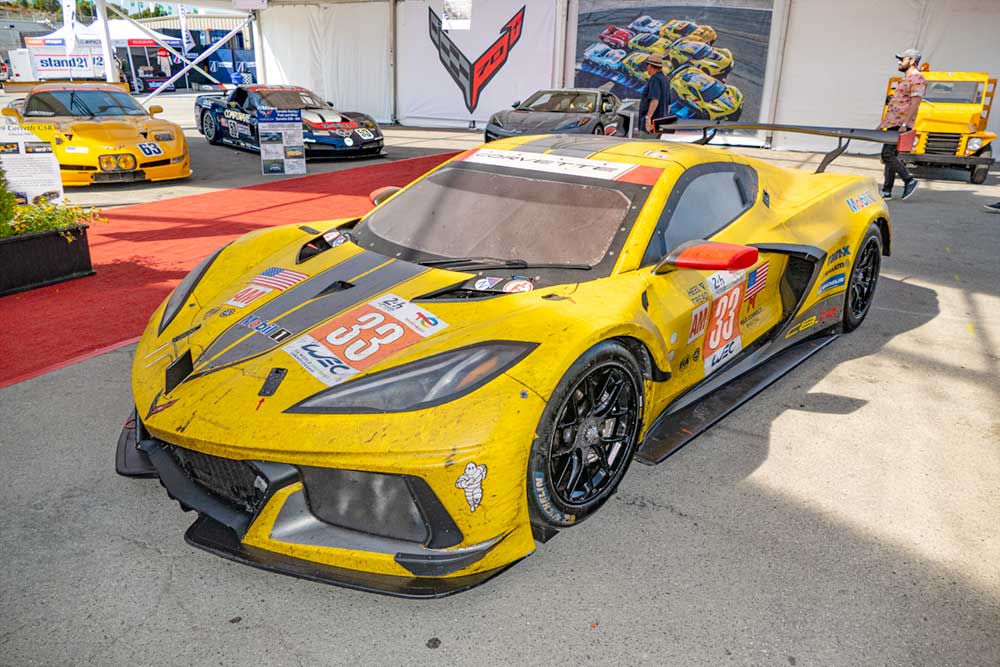
Photo Gallery



